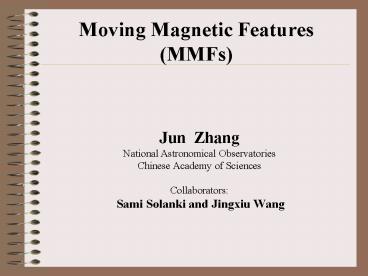Moving Magnetic Features (MMFs) - PowerPoint PPT Presentation
1 / 32
Title:
Moving Magnetic Features (MMFs)
Description:
The difference between the separation of each MMF pair near the end and near the ... A qualitative model based on these and other observations is presented. ... – PowerPoint PPT presentation
Number of Views:34
Avg rating:3.0/5.0
Title: Moving Magnetic Features (MMFs)
1
Moving Magnetic Features (MMFs)
- Jun Zhang
- National Astronomical Observatories
- Chinese Academy of Sciences
- Collaborators
- Sami Solanki and Jingxiu Wang
2
Outline
- 1. Definition of MMFs
- 2. Properties of MMFs
- 3. A qualitative model
- 4. Results
3
1. Definition of MMFs
- Moving magnetic features (MMFs) are small
magnetic features that move away from a sunspot
to the periphery of the surrounding moat (Vrabec
1971 Harvey and Harvey 1973 Lee 1992).
4
- The MMFs are generally thought to be transported
by the outward moat flow. There are two kinds of
MMFs unipolar and mixed polarity (Harvey and
Harvey 1973 Yurchyshyn et al. 2001).
5
Magnetograms and Dopplergrams of AR 8375
observed by SOHO/MDI
6
Magnetograms and Dopplergrams of AR 9236
observed by SOHO/MDI
7
Left H? images middle MDI magnetograms
rightMDI continuum images. The FOV is 172"?172".
8
- Definition of angles ? and ? (see also Yurchyshyn
et al. 2001).
9
2. Properties of MMFs
- It is still an open question about the nature of
MMFs. - We have identified 144 pairs of opposite magnetic
polarity MMFs in two active region ARs 8375 and
9236.
10
Flux distributions of the positive and negative
elements of 144 MMF pairs.
11
Distance of first appearance of MMF pairs from
the sunspot boundary.
12
Histogram of the proper motion speeds of the MMFs.
13
Histogram of MMF lifetimes.
14
Histogram showing the separationbetween
polarities of MMF pairs.
15
The difference between the separation of each MMF
pair near the end and near thebeginning of its
life.
16
Histogram of angle ? measurements of the two
investigated active regions.
17
Histogram of the number of MMFs for a given angle
? in AR NOAA 8375.
18
Relationship between ? and the change of ? over
MMF lifetime.
19
- To find the evolution of MMFs velocity fields,
we have traced 42 MMF pairs in active region AR
8375.
20
The relationship between horizontal velocity and
distance to the sunspot penumbra ofAR 8375.
21
The horizontal velocity of MMF elements is
plotted versus relative distance from MMF birth
place.
22
Left MDI magnetograms showing the northern part
of the sunspot of AR 8375 . A box outlines the
field-of-view of the following magnetograms.
Three arrows denote a negative element of an MMF
pair Right Dopplergrams. White patches show
downflow, and black, upflows. Three arrows point
to the Dopplershift of the negative element.
23
Upper panel histogram showing the Doppler shift
of the individual MMFs Lower panel histogram
showing the difference of the Doppler shift
between negative and positive MMF elements.
24
Sketch of a possible explanation of the
creation(upper frame) and motion ( lower frame)
of MMF pairs.
3. A qualitative model
25
Relationship among an umbra, a penumbra, an MMF
pair and a canopy base.
26
4. Results
- (1) The majority of MMF pairs first appears at a
distance of 1000 to 5000 km from the outer
boundary of the sunspot, although MMFs appearing
closer to the sunspot may be missed
27
- (2) MMF bipoles are not randomly oriented. The
member of an MMF pair further from the sunspot
has the polarity of the parent sunspot in 85 of
the cases. The orientations of MMF pairs are
associated with the twist of the sunspot
superpenumbra
28
- (3) The mean lifetime of the studied MMFs is
around 4 hour - (4) The separation between the two polarities
of the MMFs falls in the range of 1100 1700 km.
This separation decreases slightly as the MMF
pairs move outwards
29
- (5) MMFs tend to cluster at particular azimuths
around the parent sunspot, in particular in AR
8375 - (6) MMF pairs move approximately radially
outward from sunspots at an average speed 0.45 km
s-1. Their motion is deflected towards large
concentrations of magnetic flux of opposite
polarity to that of the parent sunspot.
30
- (7) The velocity of an MMF pair decreases
significantly (from 0.6 km/s to 0.35 km/s) with
increasing distance from the MMF's birth place. - In contrast, the decrease of the average
velocity far less obviously (from0.5 km/s to 0.4
km/s) with increasing distance from the sunspot.
31
- The change in MMF flow speed does not reflect
the radial structure of the moat flow, but rather
is intrinsic to the evolution of the MMF pairs.
The vertical velocity indicates that the elements
of MMF pairs with polarity opposite to that of
the sunspot support a downflow (Doppler redshift).
32
- A qualitative model based on these and other
observations is presented. MMF pairs are proposed
to be part of a U-loop emanating from the
sunspots magnetic canopy. According to this
model the downflow is caused by the Evershed flow
returning below the solar surface.

